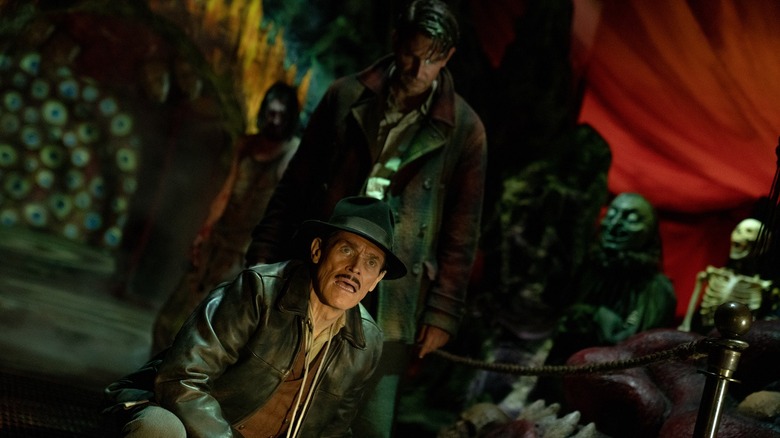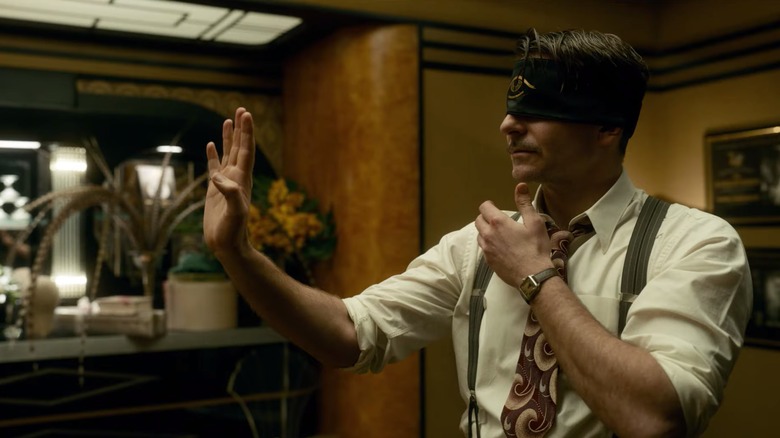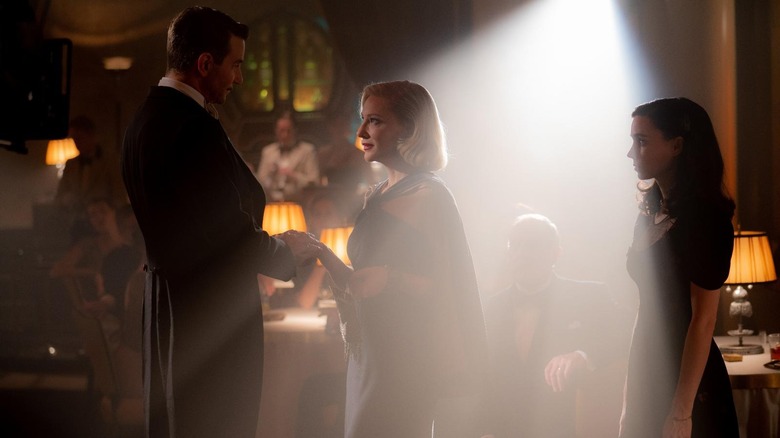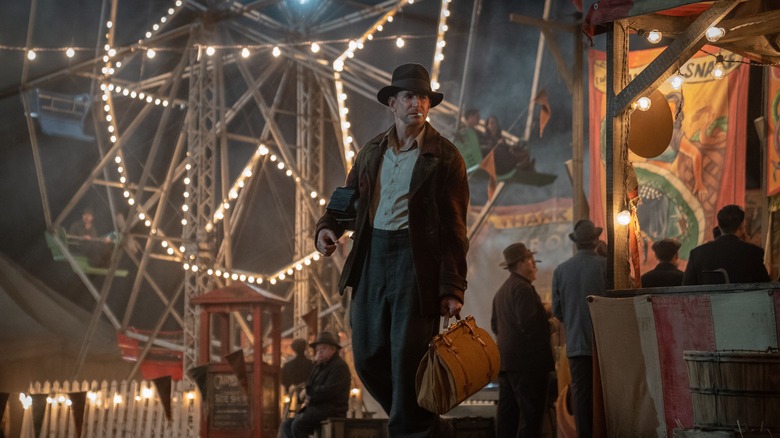
There are dark delights and darker revelations to be found in "Nightmare Alley" — both figuratively and literally. Guillermo del Toro's adaptation of the 1946 novel of the same name by William Lindsay Gresham is a grim cautionary tale of the monsters that men make, and the monstrous natures that men hide.
"Nightmare Alley" is a lush and lascivious noir that basks in the shadowy corners of society, where freaks, geeks, grifters happily reside, and where the high-powered elite only deign to drift through before returning to their pristine mansions. But what happens to the people from those shadowy corners and alleyways find their way to the hallowed halls of the uber-rich? That's what Bradley Cooper's ambitious con man Stanton "Stan" Carlisle discovers, as he works his way up from a low-ranking carnival worker to a lauded psychic who gets entangled with Chicago's most powerful and corrupt politicians along with a slinky psychiatrist (a scorching Cate Blanchett) with her own schemes. But for all his ego and ambition, it lands him right where he started.
Warning: spoilers for "Nightmare Alley" follow.
Get Him To The Geek

Stan Carlisle is a mystery for much of "Nightmare Alley," introduced in a wordless 15-minute sequence — in which he throws a body down a hole in a dilapidated house, sets the house on fire, and boards a bus to nowhere — before he finally utters his first line to a carnival's resident "geek" who had escaped his cage. "I'm not gonna hurt you," he promises, before the geek lunges at him, leading him to reciprocate and beat the poor man bloody. In just that one action, we get a glimpse of who Stan is: a man of contradictions, bad news in a handsome face, an enigma hiding a violent temperament. But as the film unfolds, we learn that Stan isn't that much of a mystery, he's just another man.
"Everybody has some trouble. Somebody they hated. A shadow of their past," alcoholic carnie Pete (a quietly devastating David Strathairn) tells Stan. Every man boils down to a series of issues and traumas, and as much as he might think of himself as a brooding loner, even Stan can be easily read like a book by Pete, who is one part of a clairvoyant act with his wife Madame Zeena (Toni Collette). Even the men who become the carnival's resident "geeks" — often destitute alcoholics or drug addicts who are culled from Nightmare Alley by the traveling carnival owner Clem Hoatley (a wonderfully skeevy Willem Dafoe) — are just ordinary men after a bad day. Geeks were a common act in early 20th century circuses; presented as the most shocking and lurid part of the "freak show," they were "wild men" who would entertain the masses by chasing live chickens and biting their heads off in a bloody display of violence. It was a comfort of sorts for the audiences, who got the temporary thrill of witnessing something so primal and brutal, while being assured that they are nothing like these feral creatures. But perhaps the differences between the civilized and the wild aren't so few, and perhaps the distinction between the light and the dark isn't that obvious.
Despite his dubious morality and secretly violent temper, Stan is presented as a character who believes in that distinction. He's disgusted by Clem's underhanded tactics to "recruit" geeks from Nightmare Alley once his current one dies — luring them in with promises of alcohol and temporary employment before essentially kidnapping them — but doesn't voice his displeasure. At least he's not like them, Stan appears to assure himself. And who would miss just another bum from Nightmare Alley?
Not Easily Spooked

But the thing that sets Stan apart from the destitute "geeks" who serve as the shocking opener of the carnival's freak show, is his aversion to alcohol and his handsome face. It's that face that lands him a job at the carnival, and that face that earns him a spot on Madame Zeena's team, after the clairvoyant takes a shine to him and offers him a job (of both varieties, if you know what I mean). Zeena's husband Pete resignedly accepts Stan as part of their team, and even as a protégé of sorts, teaching him about his and Zeena's old two-person psychic act – which he warns Stan against using, or be swept away by the power of reducing even the most sane person into a teary mess. But the one thing Stan must never do, everyone warns him, is to turn his act into a "spook show." This is when the performer leads a person to believe they have the power to contact the dead. The carnival workers who have no qualms about turning the homeless into freak shows, draw the line at giving people hope of contacting their long-gone loved ones. Because there's nothing crueler than false hope.
But Stan, of course, doesn't heed their warnings. He thinks he's above these low-life carnies and their low-level dreams — he and his young love Molly Cahill (a wide-eyed Rooney Mara) are destined for bigger, greater things. And after a mishap with wood alcohol leads to him accidentally poisoning Pete (a mistake that turns into a black spot on Stan's consciousness), Stan decides to shoot for these greater things — and essentially achieves them. Just two years later, he and Molly have perfected Pete and Zeena's old act, performing as the mentalist "The Great Stanton" and his beautiful assistant in the glamorous nightclubs of Chicago. But when one performance nearly gets derailed by Blanchett's particularly astute Dr. Lilith Ritter, Stan distracts her wealthy client Judge Kimball (Peter MacNeill) with a Hail-Mary spook show — and it works. Judge Kimball is convinced that "The Great Stanton" is the real deal, and employs him to communicate with his dead son, and later refers him to one of the most powerful, and dangerous, men in Chicago: Ezra Grindle (an alarmingly sinister Richard Jenkins).
Fatal Attractions

Ignoring Molly's protests, Stan becomes drunk on his newfound influence over these affluent men, and eventually, on the actual drink, thanks to the creeping influence of Dr. Lilith Ritter. Lilith — who not-so-coincidentally shares the name of the "fallen" first wife of Adam, a Biblical seductress and destroyer of men — becomes Stan's partner-in-crime, his confidante, and the most fatal of femme fatales. She's the one who pries open Stan's psyche in exchange for the information on her rich clients, whom he swindles for cash that they agree to share. They embark on a steamy affair as Stan becomes more intoxicated with it all — with Lilith, with the money, with the power of his private "spook shows," and of course, with the alcohol, which he begins to indulge in — breaking a lifelong avoidance of the stuff — as he opens up about his guilt over Pete's death, more of a father figure to him than his real father. But his swift meteoric rise only means a more devastating fall.
With each private session, the guilt-ridden Ezra Grindle becomes more demanding, eventually ordering Stan to conjure his illegitimate lover Dora, who died of a forced abortion. Desperate and greedy, Stan turns to an embittered Molly, who reluctantly agrees to one last performance together before she leaves his life forever. But their act goes terribly wrong: as a bloodied Molly appears in the distance as Ezra's dead lover Dora, Ezra runs and grabs her and quickly realizes that she and Stan are frauds. He threatens to end their lives but before he can call for his grunt (Holt McCallany), Stan violently beats Ezra to death — this time with no one to stop him as he was before with the geek. Molly flees the city and Stan flees to Lilith, who gives him one last show of adoration before unveiling her true nature: the conwoman who conned the conman. She had hoarded all the money for herself and used the recordings of their sessions to frame him as a mentally disturbed client. All along Stan had believed they were equals — scammers who had gamed the system, people who could bypass that rigid class hierarchy — and all along, Lilith had seen him for what he actually was: just another greedy, low-life man.
Mister, I Was Born For It

Injured and humiliated, Stan is a man reduced to his primal functions: eat, breathe, drink. On the run from the police, he once again boards transportation to nowhere — this time, hopping a cargo train which takes him right back to the proverbial Nightmare Alley, one of the many hobo camps that littered America during the Great Depression. Now a full-fledged alcoholic wearing ragged clothes and stinking of rotting flesh, Stan looks and acts no differently than the Nightmare Alley residents he turned his nose up to all those years ago. And it's like this that he wanders into a nearby carnival, hoping to get a job as a mentalist. But this carnival boss (Tim Blake Nelson) has no use for mentalists, who have long gone out of style. But amused by Stan's story about the grotesque pickled baby in a jar which he bought off a carnival that shuttered (a disturbing story that Stan had first heard so long ago from Clem), he offers him a drink. He has a "temporary" job available for a new geek. Is he interested? The realization dawns on Stan's dirty, haggard face, just as quickly as it's overtaken by an ecstatic despair. "Mister, I was born for it," he says, laughing ... or perhaps sobbing.
And there we return full circle to the beginning, except now Stan is the trembling wild man at the end of the rope, and not the man holding the rope. How thin that distinction is, how fragile our concept of civilization is, and how easily it is for a man to be reduced to the dregs of society — the "geek" who amuses the horrified gentry with his displays of violence. Stan might've been a man of above-average looks and intellect, but he can't beat the system, and for that, he is punished with a fate that he once thought others were so deserving of.
From it morally grey protagonist, to its lamplit halls, and seedy office dealings, "Nightmare Alley" lives up to its label as a noir with a delicious vigor. But it is also a cautionary tale, a morality play, a modern American tragedy, and a cogent class commentary all at once. It cautions against trying to game the system, but it also highlights a system designed to trap the emotionally and physically damaged. It points out how easy it is for a man with ambition to temporarily bypass those class divisions, only to be shoved back in his place in the most harrowing of ways. And it shows how easily men can make monsters out of each other, and unearth the monsters within themselves.
Read this next: The Best Movies Of 2021 So Far
The post Nightmare Alley Ending Explained: Of Monsters and Men appeared first on /Film.
from /Film https://ift.tt/3JmbyZh
via IFTTT
Comments
Post a Comment